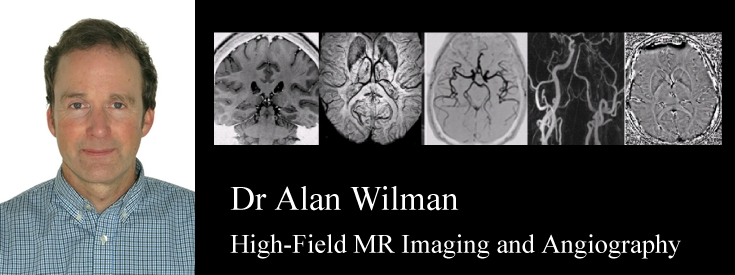Dr Alan Wilman
Contact information:
Department of Biomedical Engineering,
1098 RTF Building, 8308-114 Street, University of Alberta
Edmonton, Alberta, Canada T6G 2V2
780-492-0562 (office)
780-492-8259 (FAX)
Email: alan.wilman@ualberta.ca
Biography:
Dr Wilman is a professor in the Department of Biomedical Engineering.
BSc Physics, University of British Columbia, 1987
PhD Medical Physics, University of Alberta, 1994
Post doctorate Mayo Clinic, Rochester MN 1994-1997
His background and current training is as a magnetic resonance (MR) physicist, with a specialty in designing new MR methods for use in human MR research and clinical diagnosis.
During his PhD at U of Alberta, he studied with Dr. Peter S. Allen on the topic of coupled spins and spectroscopy. This work involved using spin quantum mechanics to analytically calculate the spin response of important metabolites in the human brain. His PhD gave him a strong grounding in NMR fundamentals and spectroscopy, but he wanted to also make a difference in clinical patient care. To do this he moved to the Mayo Clinic in Minnesota to work with Dr. Stephen Riederer. At Mayo, he applied his understanding of MR phtsics to discover new methods of performing MR angiography. These methods have been used on more than 20 million patients worldwide. He decided to return to the U of Alberta in 1997. At UofA, he received a CIHR New Investigator award to continue MR research, as well as being well supported by AHFMR (provincial research agency). Over the years his work at UofA has expanded from MR angiography and spectroscopy to high field imaging, and functional MRI. In all cases the goal is to make advances - whether these be new MR physics insight, new methods for the clinic, or new findings in human function and disease.
Current Research:
At the University of Alberta we have a 100% research 4.7 Tesla human MRI system that is the main focus of my research program. In MRI, higher fields offer the promise of increased signal and chemical shift dispersion, yet this comes at the price of increased RF heating and susceptibility effects. At 4.7T we try to balance all of these effects to obtain a new level of MRI capability. We are involved in exploiting MRI physics and engineering to enhance imaging and spectroscopic capability. In particular my group is involved in applying "pulse sequences" in new ways to gain more value from MR. We are interested in susceptibility, spin echo and relaxation methods, blood vessel imaging and spectroscopy. To date we have found a unique niche in the magnetic field continuum with few competitors around the world. See publications section for detailed reading.
We apply our advances to normal volunteers and to specific diseases where the new methods can make a difference. One of the strengths of the program is the wide range of collaborating physicians in neurological and psychiatric diseases including depression, Parkinson's disease, multiple sclerosis, blood vessel disease and dementia. Once we develop new methods, we can apply them to a wide range of diseases with their help. Current clinical work includes imaging human blood vessels, iron in multiple sclerosis and Parkinson's disease, and functional MRI of the brain.
Student Opportunities:
Students working with me generally have a strong background in electrical engineering, physics, or engineering physics. Students can enter either the Biomedical Engineering Department or the Physics Department, depending on the undergraduate degree and long term goals. Students learn how to control the MR scanner and often create new ways of performing MR experiments. Some advances can make a true difference in diagnostic imaging, while others provide new avenues for brain research. Graduating students typically find places in industry or in MRI research hospital and academic environments. Some also enter medical school. MRI remains a rapidly growing field with many job opportunities.
Publications:
Link to publication list in PubMed
